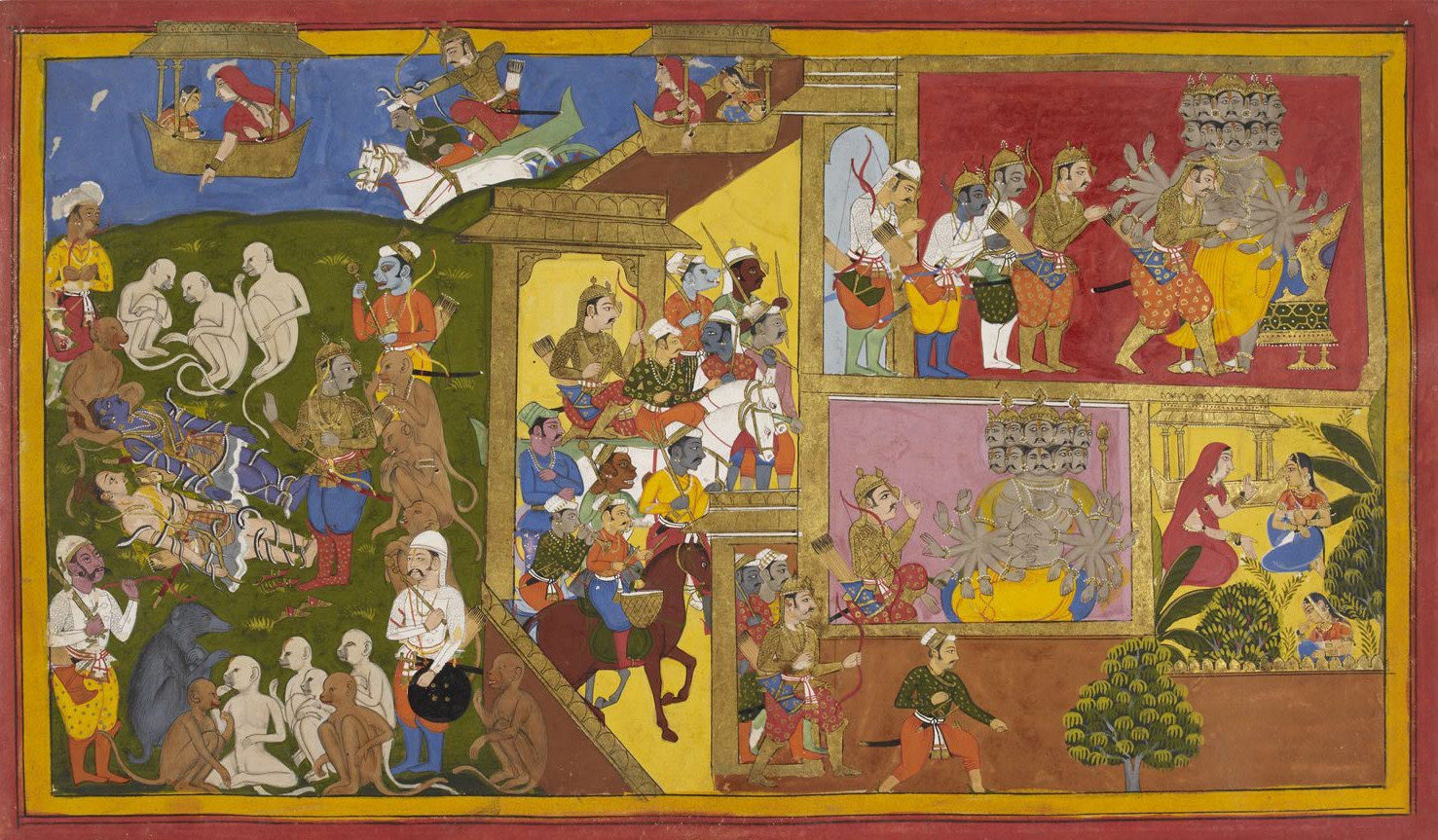Comparison Indrajit & Utagawa
To start off I have chosen to compare "Indrajit meets with Ravana, then binds Rama and Laksmana with magic serpents; Sita is told they are dead" and "Utagawa Kunisada." To start off with a little information about the artworks, Indrajit is a scene that is a part of a larger story, the Ramayana. The story focuses on the dispute of good and evil. The characters in the scene experience love, loss, loyalty, conflict, fear, and friendship. These encounters highlight one’s meaning. Utagawa is a picture, there is a woman wearing a kimono, whom is standing by a vacant carriage. Her kimono is green that matches the carriage symbolizing a connection. Her robe and headscarf indicate it is cold outside. The whole artwork represents modern beauties.
 |
| “Indrajit meets with Ravana, then binds Rama and Laksmana with magic serpents; Sita is told they are dead,” folio from the Yuddha Kanda of the Ramayana, by Sahib Din, Udaipur, c. 1650-52, watercolor on paper, approximately 9 x 15.38 inches (British Library, Add. 15297(1), f.34 r) |
The elements within the two artworks are unidentified, mysterious. Within Indrajit, The elements are very chaotic. It is very hard to tell what’s going on. In Utagawa, The elements are modest. The artwork is simple but complicated to understand. As for the elements being mysterious or unidentified, it is the same for if someone were to read the image. Indrajit could be read as a story, but difficult to understand. Utragawa is unknown. There’s Japanese writing on the wall and it has a simple work, but is hard to interpret what you were looking at. These two artworks are from the same country, but opposite sides, which is unique to compare them. Indrajit comes from India, which is the story behind the scene (as said in the beginning background information.) Utagawa is from Japan, more specifically from the Edo period.
 |
| Utagawa Kunisada I (Toyokuni III), Visiting Komachi (Kayoi Komachi) , from the series Modern Beauties as the Seven Komachi (Tōsei Bijin Nana Komachi) , c. 1821-22, published by Kawaguchiya Uhei (Fukusendō), woodblock print: ink and color on paper, 36.5 x 25.5 cm ( Museum of Fine Arts, Boston ) |
The description under the images include the name, what they are a part of, when it was published, and what type of form of art it is. For these pieces of art you definitely need to find a background knowledge to understand the stories behind the artworks. Otherwise, it will be very hard to understand what is happening in the image.
When reading the background information, it becomes aware how complex images can be. For example, looking at Indrajit, it is very chaotic and the message is unclear until you read that is based off a poem. For Utagawa, you would see a simple lost looking woman, when you read the background it explains she represents modern beauties and it is a part of a series. Within all of these points, it explains how these artworks tell a story.
Dr. Arathi Menon, "A page from the Mewar Ramayana," in Smarthistory, June 22, 2020, accessed February 14, 2021, https://smarthistory.org/mewar-ramayana/.
Dr. Sonia Coman, "Utagawa Kunisada I, Visiting Komachi, from the series Modern Beauties as the Seven Komachi," in Smarthistory, June 5, 2018, accessed February 14, 2021, https://smarthistory.org/kunisada-visiting-komachi/.
I think you have a very good start to this blog! You do say the words "to start this off" a few times, which made it a bit repetitive without meaning to, in my opinion. I would also like a bit more information behind each piece if possible, I feel like we only scratched the surface on the meaning behind the paintings. I also didn't see much comparison between the paintings. This is all easily adjusted by revisiting the pages with the information and taking notes on the deeper meaning or even some information on the artists as well. But you have a great start and you clearly understand what was written about the paintings, good job!
ReplyDeleteI like the format and setup of your blog. I do think you have good information place in the blog but also you could add even more about both art pieces and maybe get in depth about the similar and different characteristics of the art works. But I like the blog with even more added it can be even better.
ReplyDeleteI also chose these two works and found that they were very complex pieces. I do not think they can be explained with limited detail. You started off strong and then towards the second half, the blog became a little weak, even with the simple explanation of the two pieces. Overall, I think the blog has potential but as of right now is kind of lacking in areas where it needs the most.
ReplyDeleteI really like your layout of the blog it was very easy to read. I think the best thing you could do to improve on your blog is add a little bit more background on each piece. I think you sort of summarized it in the beginning, but just embellishing it a little and adding a little history would really complete your blog!
ReplyDelete